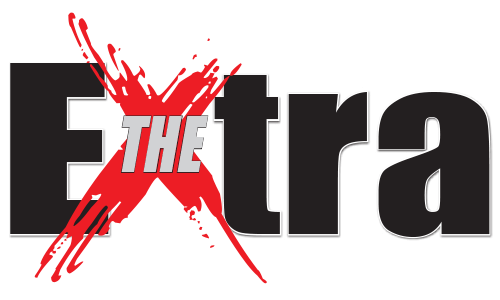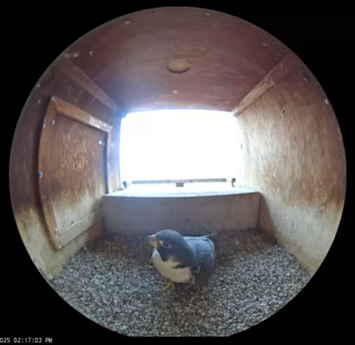Minnesota DNR FalconCam pair preparing for eggs
A pair of peregrine falcons have returned to the nest box featured on the popular Minnesota Department of Natural Resources FalconCam (mndnr.gov/falconcam). The webcam has captured this pair of falcons demonstrating courtship displays and preparing for eggs by creating a nest in the gravel, called a scrape.
The two adult falcons using this nest box have been identified by the Midwest Peregrine Society as the same pair who used it last year, a 12-year-old female and a 16-year-old male. This female falcon fledged from St. Cloud, Minnesota and has nested in this box since 2016. The male fledged from Gary, Indiana and this represents his second year paired with this female.
The FalconCam, located inside a nest box in downtown St. Paul, became the DNR’s first live webcam 14 years ago. Building tenants at Sentinel Properties provide funding for the live camera stream and the building managers oversee the nest box and camera. The webcam provides an intimate view into the lives of nesting peregrine falcons each year.
“We hope the FalconCam generates appreciation of this fascinating species of special concern and helps connect Minnesotans to the incredible wildlife around them,” DNR Wildlife Engagement Supervisor Jessica Ruthenberg said. “Last year, this pair successfully fledged two chicks from their nest. We hope for a chance to see them rear a family again this year.”
Peregrine falcons are a Minnesota success story. In the 1970s, they were on the brink of extinction in North America. Populations were restored with the help of Minnesota falconers, the Midwest Peregrine Society and the DNR Nongame Wildlife Program. Donations from generous Minnesotans on income tax forms helped to fund the peregrine falcon restoration project and the DNR FalconCam.
Since 1987, Minnesotans have been able to donate to the Nongame Wildlife Fund on state tax forms to fund projects that support the future of our state’s rare and vulnerable wildlife.
Watch the DNR FalconCam to see the falcons engaged in courtship and maintaining their scrape, as they prepare for their nesting season. Last year, this pair laid their first egg on April 11, so an egg could potentially appear around that same time this year.
Stay informed on FalconCam happenings by signing up for updates on the FalconCam webpage. Learn more about peregrine falcons and the Minnesota restoration project on the DNR website (mndnr.gov/eco/nongame/projects/peregrine.html)
Test to be sure all’s well with your water well
MDH – More than 4 million Minnesotans rely on groundwater for their drinking water, and 1.1 million of them get that groundwater from a private well.
Wells can be a source of high-quality drinking water, but they require regular maintenance. If groundwater becomes contaminated, it can affect the health of those who drink it. During National Groundwater Awareness Week — March 9-15 — officials at the Minnesota Department of Health (MDH) are reminding private well owners about the importance of yearly well testing.
The five most common contaminants in Minnesota are nitrate, coliform bacteria, arsenic, lead and manganese. MDH recommends that well owners test for nitrate and coliform bacteria every year and for arsenic, lead and manganese at least once.
“You can’t taste, smell or see most contaminants, so testing is the only way to know how safe your water is,” said MDH Water Policy Manager Tannie Eshenaur. “Well testing is particularly important if babies or pregnant people will be drinking the water.”
MDH recommends using an accredited laboratory for well testing (Search for Accredited Laboratories). If testing identifies any contaminants, treatment options can include:
• Installing point-of-use or whole-home filters, such as reverse osmosis or a water softener.
• Repairing cracks where contaminants are entering the well.
• Building a new well.
A limited number of grants and low-interest loans are available to help offset water treatment costs (Financial Assistance for Home Water Treatment and Well Construction, Repair, and Sealing).
More information to understand well testing, results, and options for treatment is on MDH’s website.
DNR sets open water fishing regulations for Upper Red Lake
Anglers fishing on Upper Red Lake during the 2025 open-water season that starts Saturday, May 10, will have a five-walleye possession limit, with only one walleye over 17 inches allowed.
“Upper Red Lake female spawning walleye have been managed at a level that has resulted in a number of strong year classes recently,” said Edie Evarts, Minnesota Department of Natural Resources area fisheries supervisor for Bemidji. “The summer regulation is an opportunity for anglers to keep abundant young walleye while also maintaining the breeding fish at a level that continues to produce successful year classes.”
To continue producing the most successful year classes, enough female spawning walleye need to be present to produce lots of newly hatched walleye (known as fry). But if there are too many spawning walleye present, they produce too many fry. When fry are overabundant, the young fish don’t survive well because they are competing for a limited amount of food.
The regulation that begins May 10 aims to keep the lake’s stock of female spawning walleye in an ideal range by focusing angler harvest on the abundant immature fish under 17 inches, so future numbers of spawning walleye are not higher than desired. The regulation also aims to make sure overall harvest does not exceed agreed upon levels.
“We now have 20 years of data from managing the lake since the walleye fishery reopened in 2006 and a good idea of the impact of fishing regulations from our annual angler creel surveys,” Evarts said.
Walleye management on Red Lake is a collaborative effort between the Red Lake Nation and the Minnesota DNR, governed by a joint harvest plan revised by the Red Lakes Fisheries Technical Committee in 2015. Winter harvest regulations for 2025-2026 will be determined after the summer fishing season and completion of fall assessment netting.
The Upper Red Lake Citizen Advisory Committee reviews walleye harvest totals and regulation options and provides recommendations for the state waters of Upper Red Lake. Upper Red Lake fishing regulations are available on the Minnesota DNR website (mndnr.gov/fishing/upper-red-lake-regulations.html).
Anglers are reminded to protect Upper Red Lake and all Minnesota waters from aquatic invasive species by cleaning and draining watercraft and equipment and disposing of unwanted bait in the trash. A decontamination station is available at the Tamarac River Big Bog Public Water Access, referred to locally as Homestead Park.


